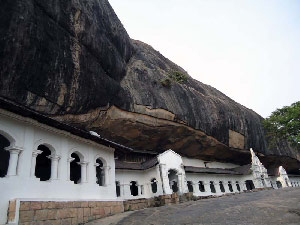
Dambulla Cave Temple
Sri Lanka's Largest Rock Cave Temple built on a 600 feet
high Rock

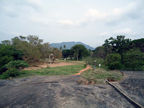 Located at an elevation of 1118 feet from the sea level
rises a massive rock from the surrounding plains of Dambulla of 600 feet high
and over 2000 feet in length. It is home to the Worlds most acclaimed Cave
complex of magnificent Buddha Images and Rock Paintings of vivid colours and
shapes constructed and painted from around 2nd Century BC (Anuradhapura era )
and continued up to the Kandyan era of the 18th Century. Sinhalese people call
it as ' Dambulu Gala' ( Dambulla Rock) and the Temple is called as the '
Rangiri Dambulu Viharaya' (Golden Rock Dambulla Temple).
Located at an elevation of 1118 feet from the sea level
rises a massive rock from the surrounding plains of Dambulla of 600 feet high
and over 2000 feet in length. It is home to the Worlds most acclaimed Cave
complex of magnificent Buddha Images and Rock Paintings of vivid colours and
shapes constructed and painted from around 2nd Century BC (Anuradhapura era )
and continued up to the Kandyan era of the 18th Century. Sinhalese people call
it as ' Dambulu Gala' ( Dambulla Rock) and the Temple is called as the '
Rangiri Dambulu Viharaya' (Golden Rock Dambulla Temple).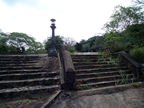 The Dambulla Rock Temple had first been constructed during
the rein of King Vattagamini Abhaya ( 103 BC and 89-77 BC ). The Sinhalese
often call him as King Valagamba. During a South Indian invasion the king had
to abandon his Anuradhapura Kingdom . For 12 years, King Valagamba was in
hiding and had frequented these caves for his safety. After regaining the
kingdom of Anuradhapura and becoming the King, to show his gratefulness for his
safe place, he converted those caves into Buddhist Temples by constructing
walled partitions under the rock overhang which spans the entire area as a
single large cave. He got drip ledges made along this large cave and made it
suitable to withstand rainy weather and avoided water seeping inside the caved
areas. The three cave temples named as Devarajalena, Maharajalena and the
Paccimalena were constructed by him.
The Dambulla Rock Temple had first been constructed during
the rein of King Vattagamini Abhaya ( 103 BC and 89-77 BC ). The Sinhalese
often call him as King Valagamba. During a South Indian invasion the king had
to abandon his Anuradhapura Kingdom . For 12 years, King Valagamba was in
hiding and had frequented these caves for his safety. After regaining the
kingdom of Anuradhapura and becoming the King, to show his gratefulness for his
safe place, he converted those caves into Buddhist Temples by constructing
walled partitions under the rock overhang which spans the entire area as a
single large cave. He got drip ledges made along this large cave and made it
suitable to withstand rainy weather and avoided water seeping inside the caved
areas. The three cave temples named as Devarajalena, Maharajalena and the
Paccimalena were constructed by him. After King Vattagamini Abaya's rein, for several centuries
this cave temple had not come under the patronage of any other Kings until
Vijayabahu I (1055-1110 AD ), who made Polonnaruwa his kingdom. He had done
renovations to the Cave temples and it is believed that there were Buddhist
monks dwelling in this and nearby caves at that times. King Keerthi Sri
Nissankamalla (1187-1196 AD ) was much involved in uplifting the place with
many additional Buddha images being constructed and gold plating some seventy
three Buddha images in the cave temple.
After King Vattagamini Abaya's rein, for several centuries
this cave temple had not come under the patronage of any other Kings until
Vijayabahu I (1055-1110 AD ), who made Polonnaruwa his kingdom. He had done
renovations to the Cave temples and it is believed that there were Buddhist
monks dwelling in this and nearby caves at that times. King Keerthi Sri
Nissankamalla (1187-1196 AD ) was much involved in uplifting the place with
many additional Buddha images being constructed and gold plating some seventy
three Buddha images in the cave temple. King Buwanekabahu (1372-1408 AD), King Vickramabahu III
(1360-1374 AD), King Rajasinha I (1581-1591 AD) and King Vimaladharmasuriya I
(1592-1604 AD ) are the other Kings merited with the uplifting of the status of
the Temple at various times of the years gone by.
King Buwanekabahu (1372-1408 AD), King Vickramabahu III
(1360-1374 AD), King Rajasinha I (1581-1591 AD) and King Vimaladharmasuriya I
(1592-1604 AD ) are the other Kings merited with the uplifting of the status of
the Temple at various times of the years gone by.
Once stepping in from the main road, the path takes a few
hundred feet along the gravel path until one comes to the start of the rock
with a gradual ascend. On the way up there are fine viewpoints enabling to see
the surrounding landscape up to about 20 km. distance. The Cave Temple premises
needs to be accessed through the Vahalkada entrance.
Coming through the entrance leads in to the stone paved
terrace of the Cave Temple. The Bo tree is right in front and the Devaraja
Viharaya is to the right side.
Cave 1 - The Devaraja Lena - The Cave of ' Lord of the
Gods'
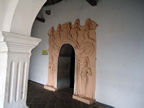


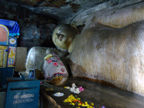 The first Cave temple is called as Devarajalena Vihara or
the Lord of the Gods Temple. The large 45 feet Sleeping postured Buddha statue
is said to be the Parinirvana status or the final passing away of the Lord
Buddha. A statue of Venerable Ananda , who was Lord Buddha's devoted disciple
is found near the feet of the colossal Sleeping Buddha statue. The God Vishnu
image which is believed to be constructed during the King Vatta Gamini Abhaya
's rein (89-77 BC ) must have given the name Devaraja Lena. The present names
of the Cave temples are said to be belongs to a period later than the initial
temple construction times as those names have first being mentioned around 1700
AD in temple history. The Buddha images belongs to a period later than 2nd
century BC as suggested by the scholars since the art of construction of Buddha
Images took place after that period in Sri Lanka. The old paintings found in
the caves had being repainted over the periods of renovations that took place
and probably date back to the 17th and the 18th centuries. Paintings of this
cave are of a faded status due to the lighting of Oil lamps and incenses by the
worshippers of earlier times.
The first Cave temple is called as Devarajalena Vihara or
the Lord of the Gods Temple. The large 45 feet Sleeping postured Buddha statue
is said to be the Parinirvana status or the final passing away of the Lord
Buddha. A statue of Venerable Ananda , who was Lord Buddha's devoted disciple
is found near the feet of the colossal Sleeping Buddha statue. The God Vishnu
image which is believed to be constructed during the King Vatta Gamini Abhaya
's rein (89-77 BC ) must have given the name Devaraja Lena. The present names
of the Cave temples are said to be belongs to a period later than the initial
temple construction times as those names have first being mentioned around 1700
AD in temple history. The Buddha images belongs to a period later than 2nd
century BC as suggested by the scholars since the art of construction of Buddha
Images took place after that period in Sri Lanka. The old paintings found in
the caves had being repainted over the periods of renovations that took place
and probably date back to the 17th and the 18th centuries. Paintings of this
cave are of a faded status due to the lighting of Oil lamps and incenses by the
worshippers of earlier times.
Cave 2- The Maharaja Lena - The Cave of ' Great Kings '
This cave is being called as the Maha Raja Vihara Lena or the Cave Temple of the Great Kings. The statues of King Valagamba and King Nissankamalla are to be found here. King Valagamba image is made out of Wood and the statue details are painted. It is placed near the cave entrance. There are around sixty images in this cave. The size of the cave is approximately 125 ft long and 75 feet broad and has a maximum height of 21 feet by the entrance to the cave. There is a Stupa in this temple surrounded with eleven seated Buddha images. The statues of gods found here belongs to Gods Saman, Upulvan, Maithree and Natha.

This cave is the largest and the most attractive due to the large number of Buddha statues of seated, lying and standing postures that depicts samadi mudra,abhaya mudra, varada mudra and vitarka mudra. A main feature of this cave is the fascinating life size granite standing Buddha statue. A Makara Torana or the Dragon Arch is constructed above this statue. This is said to be one of the gilded statues done by King Nissankamalla as parts of gold can still be seen today. This dimly lit cave has its own characteristic charm and the serenity not found in a Buddhist Temple anywhere else. The Rock paintings appearing here portrays the early Buddhist historical events. There are thousands of murals painted on the rock ceiling and the walls with impressive designs and colours. Another fascinating feature is the dripping water droplet collecting bowl placed at the right side of the cave. Even in a severe drought , this water source doesn't get dried up and said to be there since the earlier times.
Cave 3- The Maha Alut Viharaya - The Cave of ' Great
New Temple'
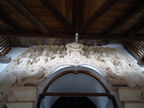

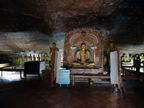 On the wall behind his statue, a mural of four of his
attendants appear. The magnificent mural paintings done on the rock has the
characteristic Kandyan style artwork and a fascinating thousand seated Buddha
image paintings on the rock ceiling.
On the wall behind his statue, a mural of four of his
attendants appear. The magnificent mural paintings done on the rock has the
characteristic Kandyan style artwork and a fascinating thousand seated Buddha
image paintings on the rock ceiling.
Old Timber Work and water drip ledges of the Rock caves

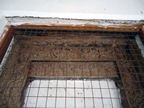
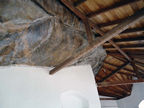 Proceeding along the passage from the cave #4 towards Cave
#5, one comes across a now partly decayed, beautifully designed timber
framework. A close view of the chiseled out drip ledge construction of the cave
is of interest too. One still cannot fathom this rock cutting technology of the
yesteryears and the technical abilities of those craftsmen who made all those
magnificent stone sculpturing all around the island's numerous temples.
Proceeding along the passage from the cave #4 towards Cave
#5, one comes across a now partly decayed, beautifully designed timber
framework. A close view of the chiseled out drip ledge construction of the cave
is of interest too. One still cannot fathom this rock cutting technology of the
yesteryears and the technical abilities of those craftsmen who made all those
magnificent stone sculpturing all around the island's numerous temples.
Cave 4- The Paccima
Viharaya - The Cave of ' Western Temple'
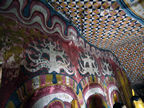

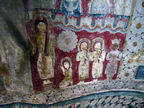 This Cave temple was
the westernmost at the earlier times but later an additional cave was added to
the west side of this cave temple. This cave measures about 50 feet in length
and 27 feet in width. The main attraction is the beautiful seated Buddha image
with a Makara Torana in ' dhyana mudra' posture. Almost identical images of the
main seated Buddha image are placed around this cave. A small dageba which was
regarded to contain the jewellery of Somawathi , the queen of King Valagamba is
situated in this cave. This chetiya is called as 'Soma chetiya' due to that
reason. There are murals painted on this small chetiya which are now in a faded
status. Statues of God Vishnu and Saman are also found in this cave.
This Cave temple was
the westernmost at the earlier times but later an additional cave was added to
the west side of this cave temple. This cave measures about 50 feet in length
and 27 feet in width. The main attraction is the beautiful seated Buddha image
with a Makara Torana in ' dhyana mudra' posture. Almost identical images of the
main seated Buddha image are placed around this cave. A small dageba which was
regarded to contain the jewellery of Somawathi , the queen of King Valagamba is
situated in this cave. This chetiya is called as 'Soma chetiya' due to that
reason. There are murals painted on this small chetiya which are now in a faded
status. Statues of God Vishnu and Saman are also found in this cave.
Temple Frontage Views



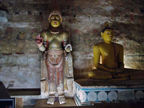


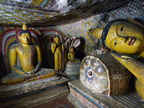



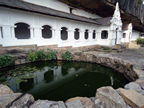
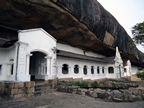
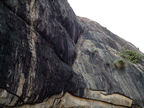

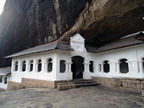
No comments:
Post a Comment